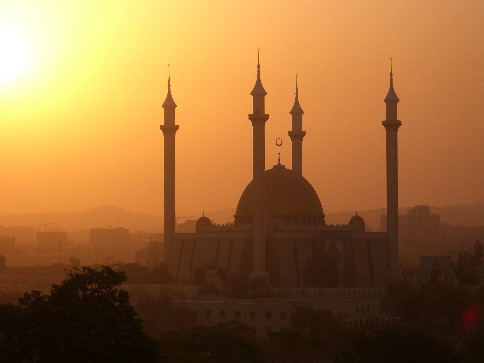 Abuja National Mosque in Abuja, Nigeria
Abuja National Mosque in Abuja, Nigeria
Four Maps that Explain Islam in Africa
As President Obama argued in his recent West Point foreign-policy speech, extremist groups such as Boko Haram and al Shabab constitute a significant threat to both regional and international security. However, while groups like Boko Haram and al Shabab desire to impose brutal, fundamentalist regimes within an Islamic framework, it is necessary to realize that the vast majority of African Muslims do not support these policies.
While many African Muslims profess a desire to see elements of Sharia law enshrined in their countries’ institutions, it, in both practice and theory, most often only applies to the personal lives of Muslims in issues such as the enforcement of dietary restrictions and arbitration of marriage contracts. In order to understand the true face of African Islam, one must move past a monolithic, orientalist view and see the religion and its adherents as they really exist. Only then can U.S. policymakers and citizens make informed, effective decisions to combat extremism and forge enduring partnerships with the African Muslim community.
These four maps, ‘Percentage of Muslims Per Country,’ ‘Size of Muslim Population Per Country,’ ‘Schools of Islamic Jurisprudence,’ and ‘Presence of Sharia Law,’ give a compelling account Islam in Africa, emphasizing where African Muslims live and how they understand the world.
Demographics
Percentage of Muslims Per Country
Data Source: Pew Research | Printable Version
Main Takeaways: The most solidly Muslim countries in Africa are located in and around the Maghreb, the Sahara Desert, and the continent’s eastern horn. The most solidly Muslim countries in Africa are: 1) Morocco, 2) Somalia, 3) Tunisia, 4) Mauritania, and 5) Sudan.
Size of Muslim Population Per Country
Data Source: Pew Research | Printable Version
Main Takeaways: The African countries with the largest Muslim populations are located in and around the Nile river delta, the Niger river delta, and the north-west Sahara. The African countries with the largest Muslim populations are: 1) Nigeria, 2) Egypt, 3) Algeria, 4) Morocco, and 5) Sudan.
Islamic Law
Schools of Islamic Jurisprudence
Islamic jurisprudence, or fiqh, is the process by which different Muslim populations interpret the Sharia, the divine law that Muhammad received from God. From the ninth century onward, several prominent jurists established separate legal schools or madhhabs, within islamic jurisprudence that orient the way Muslim populations understand and apply the Sharia.
These different schools range from more fundamentalist readings to more progressive ones, though understanding them through this dichotomy often obscures their real differences from each other. The major Sunni schools are: Hanafi, Maliki, Shafi, and Hanbali. The major Shia school is Jafari. The Ibadi school is the the legal school of the Kharijite sect.
Data Source: Emory Law | Printable Version
Main Takeaways: Maliki is the most widely-applied Sunni school in Africa and is dominant in the Maghreb, the Sahara Desert, the Sahel, and the continent’s western coast. Shafi is the second most widely-applied Sunni school and is dominant on the continent’s eastern coast. Hanafi is the third most-widely applied Sunni school and is only dominant in Egypt.
Presence of Islamic / Sharia Law
States with large Muslim populations incorporate Islamic Law, into their legal institutions and structures to varying degrees. While most African countries have non-governmental Islamic/Sharia courts to which Muslims can appeal to settle personal issues rather than using the civil/common law legal apparatus, some incorporate Islamic Law into the official legal institutions of the state. Of course, the states incorporate Islamic Law to varying degrees, which depend upon history, diverse intellectual currents, and the schools of Islamic jurisprudence to which Muslims in those states adhere.
In the map below, the countries in green incorporate elements of Islamic Law into the legal institutions of the state while those in blue do not. However, these secular countries may still offer Muslims the option to arbitrate matters of personal status through non-governmental, Islamic/Sharia courts.
Data Source: CIA World Factbook
Main Takeaways: The African countries with large Muslim populations that incorporate Islamic/Sharia law into their legal systems to the greatest extent are in the Maghreb, the Sahara Desert, and the continent’s eastern Horn.







[…] Four Maps that Explain Islam in Africa […]